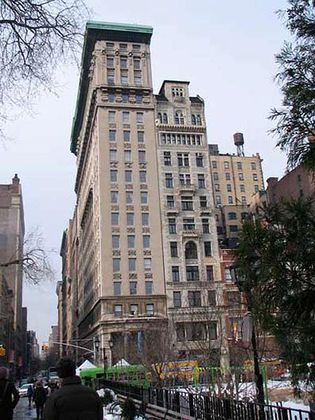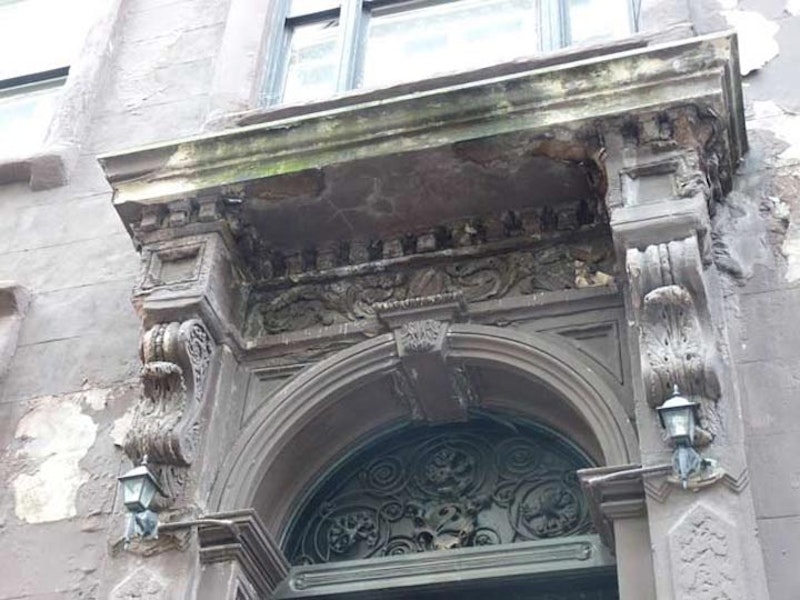I was in the Chelsea area running some errands the weekend in January we had a warm spell and went down both E. 17th and then W. 16th as far as Union Square. A short walk, and I’ll have to begin stretching these walks out again to a near three-to-four-hour comfort limit to remain in some semblance of physical conditioning. A friend who comes on the tours sometimes routinely walks 20 miles within NYC confines. If I did that, my bones and tendons would turn to Jell-O®.

109 W. 17th Street just east of 6th Ave. is a carriage house that possibly has the oldest samples of exterior lettering still extant in NYC. The building was constructed in 1869-1870 by a prominent businessman named Thomas Lord. The building was originally two stories, with the stables on the ground floor and living quarters and a hay loft on the second floor. A third floor was added in 1895 by the building’s third owner—the arched window treatments were almost identically replicated.
The building was always used as a stable and for boarding horses by a succession of owners at least until the early-1900s. Alliance Paper and Twine occupied the building from 1918-1931 and then by Charles F. Wilson, a printer’s supplies dealer, who remained until the 1960s. Until at least the 1980s, lower 6th Ave. had been a paper supplies wholesaling business as well as wholesale shoes and socks district, all this coming after the great Ladies’ Mile emporiums had scattered uptown. Beginning in the 1980s, they returned, and Bed, Bath & Beyond, Men’s Warehouse, Old Navy attract thousands on weekends.
Okay, the painted sign panels. There are two of them on the second floor, with one saying:
TO LET
CARRIAGES
COUPES
HANSOMS
And the other one:
VICTORIAS
LIGHT WAGONS
HORSES
TAKEN IN BOARD
BY THE MONTH.
Both panels feature the address number, 109.
A carriage you’re no doubt familiar with, as those are the rigs that (so their advocates claim) overworked Central Park horses drag around in romantic rides through Central Park. A coupe (spelled with an accented E and pronounced koo-PAY in French) was a four-wheeled, horse-drawn carriage that was based on the larger coach but smaller and lighter; a hansom was a lightweight horse-drawn carriage invented by British architect George Hansom, light enough to be pulled by one horse.
On the other panel, a Victoria was another carriage, but more luxurious and stylish. They were invented in France in the mid-1840s and imported to Britain in the 1860s, where they were nicknamed for Queen Victoria. Wagons were used to transport heavier materials and were pulled along by teams of horses or oxen. Lighter wagons were used to carry lighter materials.
I’d guess these signs are from the 1880s into the 1890s. There’s a certain swashiness (curved lettering) seen in those decades that you don’t see on 1860s and 1870s signage. It’s remarkable they’ve survived, as any of the building’s owners might decided to paint them over, but haven’t yet.

St. Francis Xavier Church, W. 16th St. between 5th and 6th Aves. The present church was designed by NYC’s foremost Catholic church architect, Patrick Keely, in 1878. The parish was founded by a Jesuit priest, Father James Larkin, in 1847. Don’t miss the exquisite vaulted interior. Xavier High School for boys is next door on W. 16th. Francis Xavier (1506-1552) was a Spanish-born Jesuit missionary who did extensive work in the Far East, in India, Japan and Indonesia, spreading the Gospel into countries that were still largely a mystery to Europeans at the time but were part of the Portuguese colonial influence.
This imposing edifice was completed in 1882, on the site of an earlier St. Francis Xavier’s built in 1850. Founded by Father John Larkin, a Jesuit, and named for the Jesuit saint, Father John Corridan, the mob-fighting priest.

The church is on the same block as a landmarked row of 1845 Greek Revival townhouses, as well as #41 (left), where Canadian-born songwriter Joni Mitchell wrote “Chelsea Morning,” and #24, where editor of the New York Evening Post William Cullen Bryant (1794-1878) resided for the last 11 years of his life. Poet Hart Crane also lived briefly in the building.

As soon as I passed it, I developed a fascination with #2 W. 16th St., a three-story Italianate townhouse built in 1852 by dentist John Lovejoy, according to the NYC Landmarks Preservation Commission report. Why? Well, there’s that rococo brownstone pediment above the front door; below it, the wrought iron house number (just a big “2”) on the transom; and the globular banister newel on the front steps—the other one is missing. In 1864 the owner was banker and NYC Parks Commissioner Henry J. Stebbins. It was divided into apartments between 1905-1910 and a back house, invisible from the street and accessible from W. 15th, was built in 1926. With little alteration from its 1852 construction, this is a throwback building on the block.

Heading east on 16th to Union Square, a pair of buildings from the dawn of the skyscraper era can be best seen from the square. On the left is the silvery 1903 Bank of the Metropolis Building (Bruce Price, architect) that is actually wider on the 16th St. side. The bank was founded in 1871 and was absorbed by the Bank of Manhattan in 1908, just five years after the building opened.
Immediately to the right is the Decker Building, completed in 1893 by architect John Edelmann, an associate of Louis Sullivan. The Moorish-style building was the home of the Decker Piano Company when it opened, replacing an earlier Decker Piano building. This was home to the second location of Andy Warhol‘s Factory between 1968-1974; it was here that a disturbed Valerie Solanas shot and wounded Warhol June 3, 1968.
On Union Square North (E. 17th St.) is the red brick Queen Anne-style Century Building (1881, architect William Schickel) originally home to The Century Magazine and St. Nicholas Magazine for children. For over 25 years it has been home to a branch of Barnes and Noble booksellers.

On E. 16th, a wide painted ad advertises Crown Coat Fronts (out of the picture to the right, a smaller sign says ”Mftr’s of Civilian and Military Coat Fronts.” According to painted ads expert Walter Grutchfield, the company was here between 1947 and 1958. “Coat fronts” were a “trade term for a built-up stiffening or shape-retaining interlining for the fronts of coats, made of stitched layers of haircloth, felt and canvas.”
Look closely at the left side of the Crown ad, and you can see that the paint has worn off sufficiently to allow a glimpse of the painted ad that preceded it, for Hyman and Oppenheim Human Hair Goods.
—Kevin Walsh is the webmaster of the award-winning website Forgotten NY, and the author of the books Forgotten New York (HarperCollins, 2006) and also, with the Greater Astoria Historical Society, Forgotten Queens (Arcadia, 2013)

